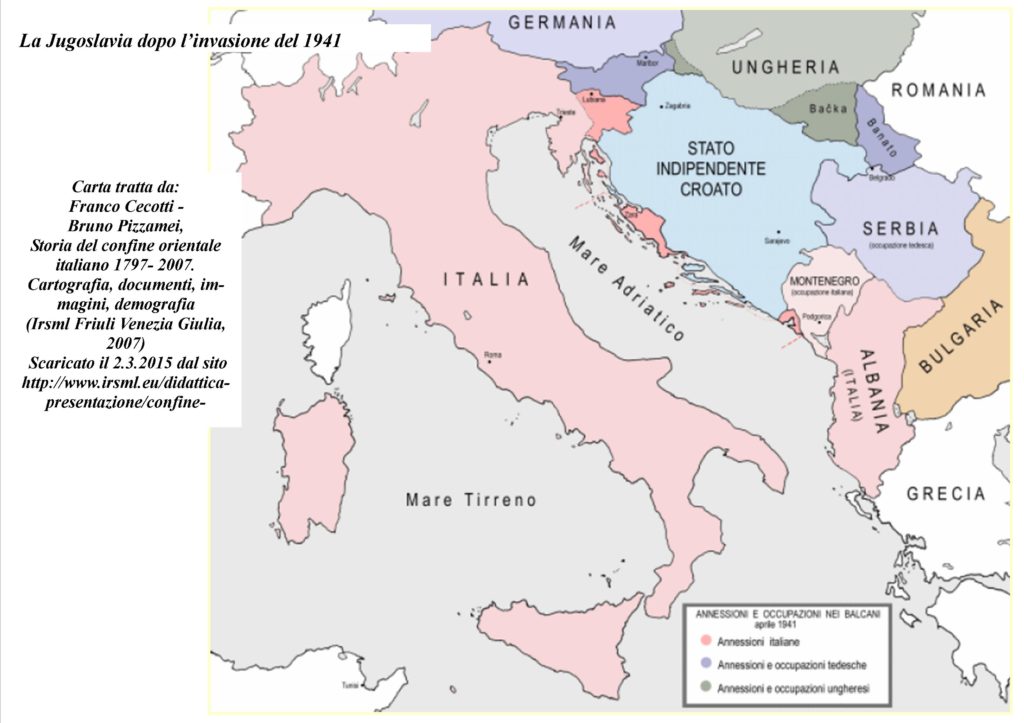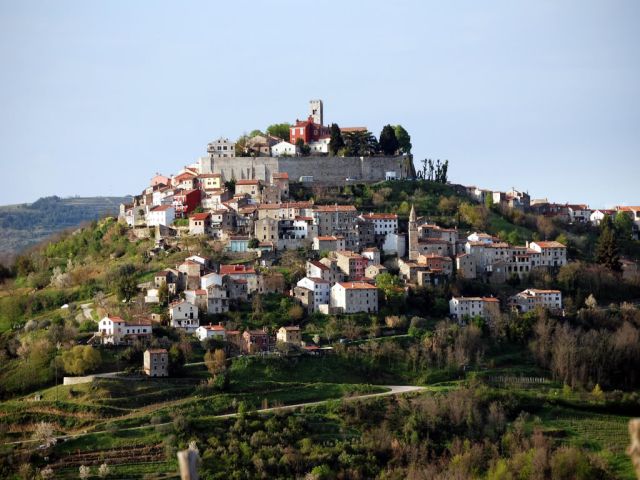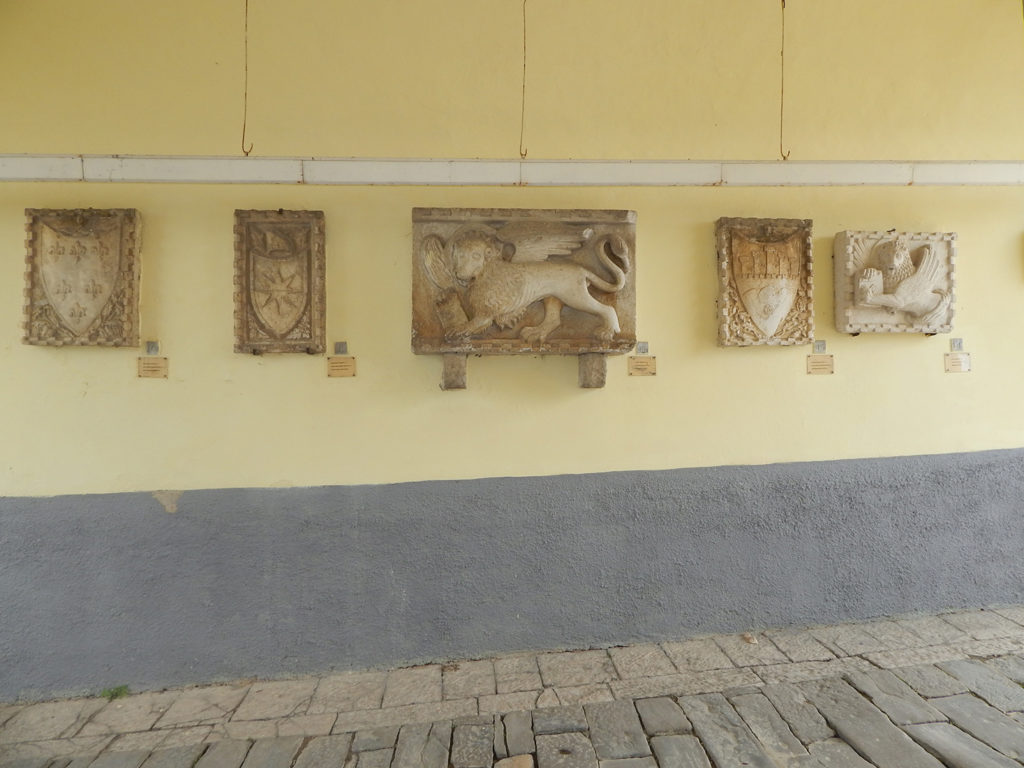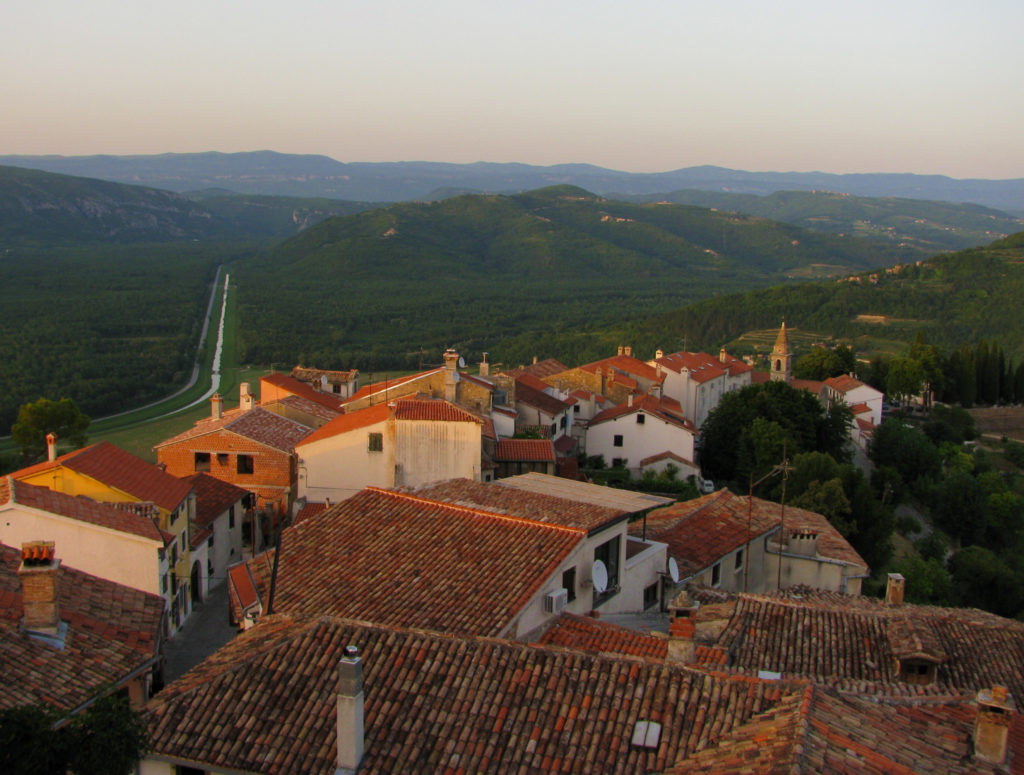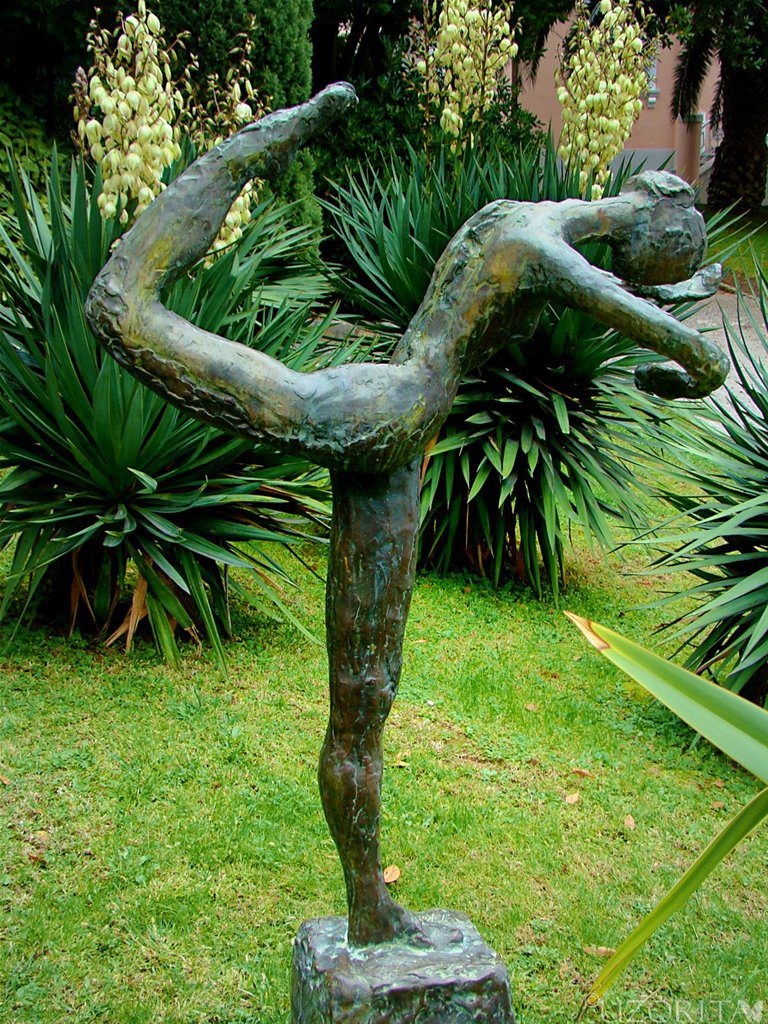Now let’s take a look at what happened in Istria
After World War II.
In 1941, as the Second World War raged, a map of the region looked like this:
When Italy surrendered in 1943, the Tito led Partisans, who’d been an exceptionally effective fighting force during the war, marched into Istria and occupied the region as far west as Trieste. The Yugoslavs quickly organized the National Liberation Committee of Istria which just as quickly passed a resolution separating Istria from Italy and annexing it to Yugoslavia.
The immediate aftermath of the N O V’s occupation of Istria becomes both murky and ugly. There’s little doubt that the Partisans prosecuted a series of ruthless purges against the native Italian population and those they suspected of collaborating with the Fascists. These came to be known as the Foibe Massacres. The motives are as speculative as the number of people executed.
Some historians think the assaults were aimed at eliminating potential enemies of communist Yugoslav rule while others opine that the Yugoslavs were exacting retribution for decades of Italian suppression. Or, it could have been simply to create a Slavic majority on the ground thus legitimizing Yugoslavia’s annexation of Istria – a form of ethnic cleansing, if you will.
Regarding the number of people killed, some reports put it at a few hundred while others claim it was tens of thousands. The purges were accompanied by Yugoslav nationalization efforts akin to those the Italians has used between the two world wars including the expropriation of property. Thus, in addition to the unknown number killed, upward of a quarter million Italians left the peninsula in what’s known as the Istrian Exodus. These alleged war crimes were never prosecuted and since there’s evidence that both sides engaged in these activities, it’s likely ignored but not entirely forgotten.
By the war’s end in 1945, the Yugoslavs had legal control over most of the peninsula with only the areas from Trieste to Novigrad and around Pula remaining under Anglo-American control. The Paris Peace Treaty of 1947 ceded control of the southwestern section around Pula to the Yugoslavs while the territory from Trieste to Novigrad remained under some dispute with the Yugoslavs being granted some dominion over all of that northwest section except Trieste. The situation that established the existing boundaries didn’t settle formally until the Treaty of Osimo in 1975.
Motoring on to Motovun.
Our first stop in the inland of Istria was the hill town of Motovun. My first impression of the countryside was that if you’re traveling in Europe and want¬†to experience Tuscany but more economically and¬†without the hordes of other tourists Istria should be your choice.
Pat’s photo of the countryside is representative of the central part of Istria.
I’ve read that there are upwards of 100 hill towns remaining on the peninsula and many of them¬†retain the medieval¬†appearance that draws¬†visitors. The town we’re going to visit, Motovun, is among the most popular destinations for those who come to this part of Istria.
About 500 people live within the walled part of the city with an equal number living in the municipality. The crest of the hill is about 270 meters above sea level so from there you have an expansive view of the surrounding countryside. The walls were built in 1278 when the Republic of Venice controlled the region.
Start by walking up the steep hill
  where you can encounter local craftspeople, like this wood carver
 where you can encounter local craftspeople, like this wood carver
or shops that feature local wines and, a specialty of the region, truffles in myriad forms – oils, cheeses, candy, and so on,
before passing through the town’s twin gates
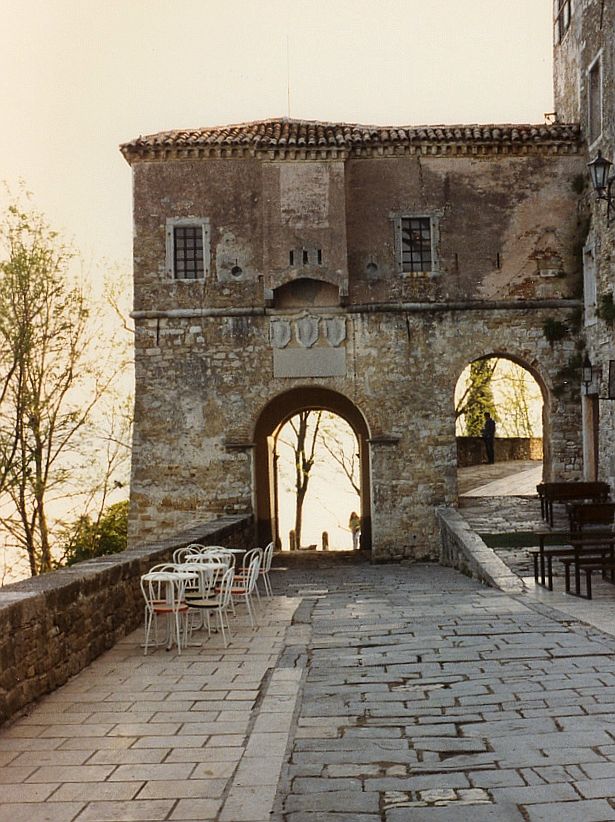 [Photo by Ulrich Prokop from Wikimedia].
[Photo by Ulrich Prokop from Wikimedia].
The gate on the left has a lapidarium
with stone reliefs from the Middle Ages and earlier.
Wander the small town and spot buildings constructed in Romanesque, Gothic, and Renaissance architectural styles such as the late Renaissance Old Church of Saint Stephen.
Or, take a deep breath, pause, and enjoy some spectacular panoramic views (as seen in these photos from Pat and Wikimedia).
Make a complete circuit of the town and you’re bound to see this giant straw figure:.
If you have a guide or are with a local who knows, they will tell you that the straw giant represents Veli JoŇĺe who is the main character in an eponymous¬†story published in 1908 by the Croatian writer¬†Vladimir Nazor. The story (as I understand it), which Nazor centered around Motovun,¬†is based on local folklore but the character has a much deeper allegorical meaning for Croatians in general and Istrians in particular. Like Croatia, JoŇĺe suffers may trials and tribulations but in the end, confronted with a choice of returning to Motovun to be a serf of leaving to be a free man, he chooses freedom.
A nose against a sea of truffles.
Long ignored by the local population, the truffle has grown to become an important player in Istrian cuisine and the Istrian economy. Although we were a short distance west of Buzet, Istria’s self-proclaimed “city of truffles,” we’d be headed that way for lunch. Enroute, Damir and our guide arranged for us to meet with Valli, a local truffle hunter, and his dog Rikki.  ¬†Mid-August is the season for black truffles and on the second Saturday in September, Buzet holds the Festival of Subotina marking the start of the season for the even more highly prized white truffle. Then, in October in Livade, close to Motovun, there’s an event called Truffle Days that celebrates the importance the truffle has in Istrian cooking.
¬†Mid-August is the season for black truffles and on the second Saturday in September, Buzet holds the Festival of Subotina marking the start of the season for the even more highly prized white truffle. Then, in October in Livade, close to Motovun, there’s an event called Truffle Days that celebrates the importance the truffle has in Istrian cooking.
With our guide serving as translator, we learned how the dogs are first tested then trained beginning as early as when they are two months old to smell out the truffles, dig them out (but not eat them), and eventually even train the younger dogs. Dogs that succeed in their training, which usually requires about six months, are called breks. Valli and Rikki gave us a brief truffle hunting demonstration but the ground and the season were both a bit dry – moist ground promotes growth, makes digging easier and intensifying the scent. I think the truffle Rikki found had been placed there by Valli but it was a nice diversion.
Stopping for a traditional lunch, we ate at a restaurant high on a hill overlooking the valley below and were entertained by both a troupe of singers and dancers dressed in native costume (that I think might have been brought in to amuse a group of Aussie tourists who sat at an adjacent table) and an unplanned downpour. When the rain stopped, we proceeded on to Buzet to visit the Distillery AurA Рbecause no day on this trip would be complete without some alcohol related activity.  AurA produces fruit and herb-based brandies as well as jams, jellies, and other products. This video reasonably sums up what we saw and experienced (although the video has a much younger crowd):
We returned for a final night in Opatija and, because we’d had a rather heavy lunch, I’d decided to make my dinner an ear of roast corn sold by one of the many street vendors followed by some ice cream. Diane joined me as we wandered the town a bit more and¬†took another stroll¬†along the Lungomare. After dinner, we decided to return to the restaurant where we’d shared a beer and some deep conversation the night before. We had the same server and she remembered us. She asked if we’d like the same set up we’d had the previous night.
I think it was Rick Steves who wrote that Opatija is not a typical Croatian beach town going on to describe it this way:
In the late-19th-century golden age of the Austro-Hungarian Empire, this unassuming village was transformed into the Eastern Riviera, one of the swankiest resorts on the Mediterranean. While the French, British, and German aristocracy sunbathed on France’s C√īte d’Azur, the wealthy elite from the eastern half of Europe ‚ÄĒ the Habsburg Empire and Russia ‚ÄĒ partied in Opatija.
While the Habsburgs and Russians are long gone, Opatija retains the trappings of its genteel past. Most of Croatia evokes a more ancient Mediterranean, but Opatija whispers “belle √©poque.” With its welcoming and elegant promenade, it may be the classiest resort town in Croatia, with more taste and less fixation on postcards and seashells.
Certainly, there are some tourist trappings in this lovely seaside town but you can also find many quiet spots and whimsical sculptures that pop up seemingly at random – such as this one of Miroslav KrleŇĺa
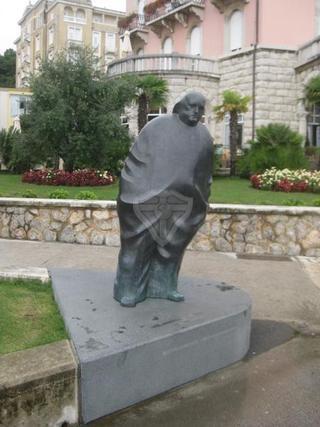 who is considered by many to be the greatest Croatian writer of the 20th century. Or this one of the Boatman of Opatija (known as barkajol).
who is considered by many to be the greatest Croatian writer of the 20th century. Or this one of the Boatman of Opatija (known as barkajol).
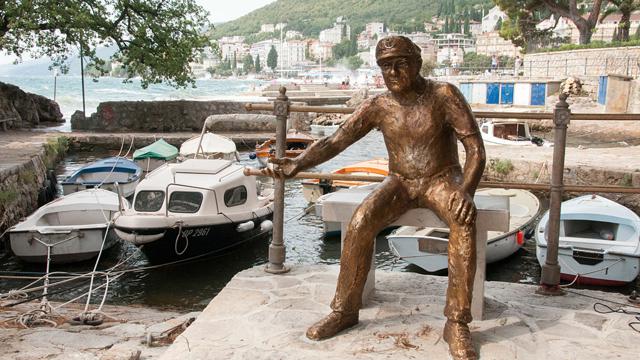 Or even this one of Isadora Duncan.
Or even this one of Isadora Duncan.
Tomorrow, we’ll leave not only Opatija but Croatia.¬†The final stop on our tour of the Balkans is a visit¬†to¬†Slovenia – the smallest of the former Yugoslav republics that is now an independent state, and its charming capital city, Ljubljana.
